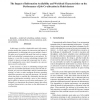Free Online Productivity Tools
i2Speak
i2Symbol
i2OCR
iTex2Img
iWeb2Print
iWeb2Shot
i2Type
iPdf2Split
iPdf2Merge
i2Bopomofo
i2Arabic
i2Style
i2Image
i2PDF
iLatex2Rtf
Sci2ools
ICPADS
2006
IEEE
2006
IEEE
The Impact of Information Availability and Workload Characteristics on the Performance of Job Co-allocation in Multi-clusters
In this paper, we utilize a bandwidth-centric job communication model that captures the interaction and impact of simultaneously co-allocating jobs across multiple clusters. We make use of a parallel job model that seeks to capture both local and global communication access patterns. By doing so, we are able to explore scheduling strategies that attempt to improve average job turnaround time by selectively mapping jobs across cluster boundaries in a process known as job co-allocation. In this research, we focus on scheduling strategies that make use of available information such as network link utilization, per-processor bandwidths, and job communication topology in order to make intelligent decisions regarding application partition sizes and job placement. We provide results that help to establish the relationship between the quantity of information available a priori to the scheduler and its ability to improve overall system performance. Additionally, we demonstrate the dramatic imp...
| Added | 11 Jun 2010 |
| Updated | 11 Jun 2010 |
| Type | Conference |
| Year | 2006 |
| Where | ICPADS |
| Authors | William M. Jones, Walter B. Ligon III, Nishant Shrivastava |
Comments (0)

